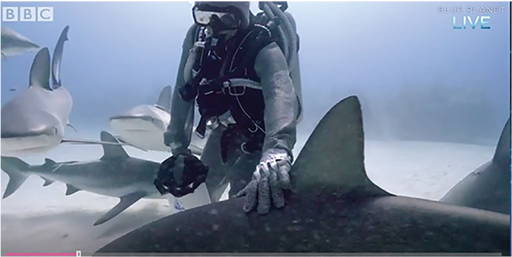1 Electronics everywhere
Begin by considering the following situation:
You are sitting at home watching the television, and a woman in a diving suit, surrounded by sharks is speaking directly to you, live on television from the Caribbean (Figure 1).
It is possible to take this type of situation for granted, but when thinking about it more closely you might wonder how this is possible. How can someone swimming underwater in the Caribbean be seen and heard by you in your house in the UK?
In this course you will start thinking about everything that’s involved in these electronic systems – from signal processing to control and communications – which allow you to watch a live broadcast from the Caribbean.
If you have studied some electronics before, you may be familiar with analogue components such as resistors, capacitors and inductors, as well as more complex components such as the operational amplifier. You may also know something about digital circuits, which include logic gates, microprocessors and even software. And you may be aware of some of the fundamental principles that describe the way that voltages and currents in a circuit are related, including Ohm’s law and Kirchhoff’s voltage and current laws.
Whilst all of this is necessary to understand electronics, it doesn’t really explain how electronics allows you to watch a live broadcast from the Caribbean. In part, this is due to the sheer scale of electronic systems. A typical computer in 2020 has around 10 000 000 000 (or 10 billion) transistors. Nobody could sit down and design such a computer armed with Ohm’s and Kirchhoff’s laws alone. Electronic systems have to be broken down into subsystems, and these subsystems in turn have to be broken down into further subsystems. Go far enough and you’ll find that you can explain what is going on using Ohm’s and Kirchhoff’s laws, but that’s a long way down.
At a higher level, when designing subsystems, descriptions like ‘the control subsystem’ or ‘the communications subsystem’ are used. These are designed using principles that describe the function of the subsystem. An electronics engineer would use these system-level principles to design the subsystem, then implement it electronically.
So, what are the systems and subsystems that allow you to watch someone swimming with sharks live on television?

